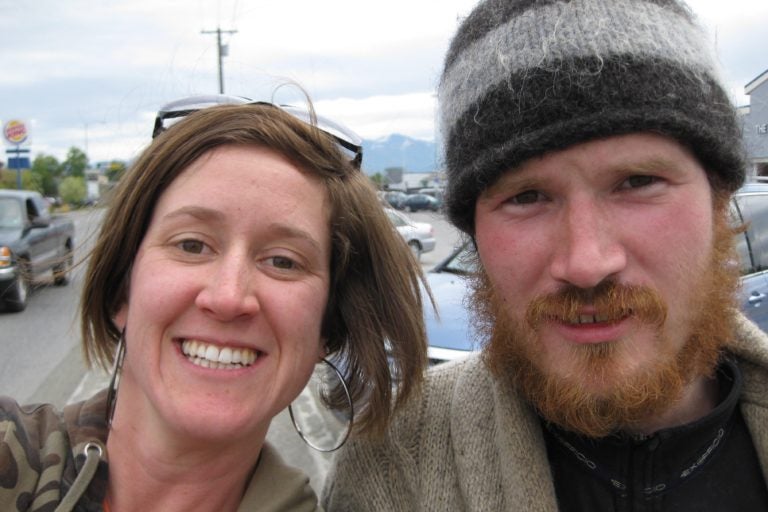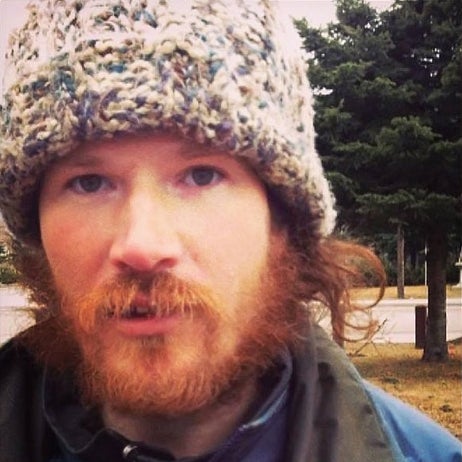Finding help for schizophrenia in a ‘broken’ system
How America’s mental health care system is creating crises instead of preventing them.
Listen 17:16
Writer Marin Sardy and her brother, Tom. When Tom was first diagnosed with schizophrenia, Marin and her family did everything they could to get him help. There was just one problem: Tom refused to accept it. What resources are available to families with loved ones experiencing a mental health crisis? How do you force someone to get help? (Image courtesy of Marin Sardy)
This story is from The Pulse, a weekly health and science podcast.
Subscribe on Apple Podcasts, Stitcher or wherever you get your podcasts.
A crisis situation is often the first introduction people have to America’s mental health system, which can be confusing, unresponsive, and difficult to navigate. Where do you turn for help? Who do you even call?
Marin Sardy remembers the exact moment she realized that her brother Tom was sick.
“My brother called me on the phone, and he started talking about matrices that he was creating in his head,” Sardy said. “That he was generating these images, and manipulating them and moving them around.”
Tom was in his early 20s and had recently dropped out of college. He’d always done his own thing — but on this call, the longer they talked, the more strange things he said.
“As the conversation proceeded, it became clear to me that this wasn’t something that he was speaking of entirely inside his head,” Sarin said. “It was as if it was a complete reality that he was engaging with.”
Sardy doesn’t remember exactly what he said that made it clear to her he was sick — what she remembers is how she reacted after their call.
“I hung up the phone, and just completely fell into a state of panic and terror and crying,” she said.
Because Sardy knew what this was — and she knew what was coming.
Growing up with schizophrenia
Sardy’s exposure to mental illness, and the mental health care system, started when she was 10 years old and her mother was hospitalized with what turned out to be a form of schizophrenia.
Sardy wrote a memoir about mental illness and her family, called “The Edge of Every Day: Sketches of Schizophrenia.” In it, she calls schizophrenia the “shapeless thief” — this strange illness that crept into their lives, and stole her mother away, bit by bit.
Schizophrenia is a profoundly isolating disease, largely because of its biggest and most destructive symptom, psychosis — which is when someone loses touch with reality and becomes immersed in delusions.
There are a few common types of delusions connected with schizophrenia: for instance, the idea that someone else is controlling your mind, or vice versa; delusions of grandeur, believing that you’re a prophet or even a god; erotomanic delusions, believing that someone, usually a celebrity, is in love with you.
One of the most common types is the persecutory delusion — the idea that someone or something is after you.
That was the case with Sardy’s mother, who early on in her illness became convinced that some dark force was pursuing her. Sardy recalled times when her mother would take their family to stay in hotels, or barricade them inside the house to protect them from assassins.
All that led to a pretty chaotic home life for her four kids — Sardy, her two sisters, and Tom, the baby of the family.
“When we were at my mother’s house, my brother and my younger sister and I were a little bit feral, I think you could say,” Sardy said.
She and her siblings got used to running wild around their neighborhood in Anchorage, Alaska. And because of their mother’s absence — mental and emotional, if not physical — they came to rely on one another, bonding in a way that only kids raised in the midst of chaos and trauma can. Sardy said she and Tom had an especially strong connection.
“He was so fearless,” she said. “I was always very hesitant. I was always very sensitive. I would hang back, I would fret. And so Tom was important to me as a person who could kind of cut through that, and help me, like, get things done.”
Confronting Tom’s diagnosis
But Sardy knew that schizophrenia was one problem that would be difficult to solve.
“My experience with my mother had sort of trained me to feel powerless,” she said. “I think part of me just assumed there was nothing I was going to be able to do for my brother. And I think I was crying about that too.”
Schizophrenia is profoundly disabling — it affects cognitive function, ability to communicate, relationships, health — and has even been shown to shave years off of people’s life spans.
There’s no cure for schizophrenia, but its symptoms can be managed over the long term using medication and therapy. Recent research shows that early intervention could be key to warding off some of the most serious outcomes.
But Sardy and her family were facing a significant barrier to helping Tom: He didn’t believe that there was anything wrong with him.
“Tom just sort of outright rejected the idea that there was a problem,” Sardy said.
It’s a common problem among people with schizophrenia, one Sardy and her family had already faced with her mother. In desperation, Sardy turned to the internet.
“I Googled the question, ‘How do you convince someone with schizophrenia to seek treatment?’” she said. “And what I found was very little actual advice on how to do that. Instead, what I found was a broad network of people who were in my position; loved ones, family members, who were trying to figure out how to help people that they loved, and were communicating with each other, supporting each other, asking one another questions, and just trying to sort of fill that hole.”
How ‘we effectively broke our system’
One reason so many families find themselves in this bind is America’s legal standard for involuntary hospitalization, said Dominic Sisti, a medical ethicist at the University of Pennsylvania.
“We have such a high bar for providing [compulsory] treatment to individuals, that a lot of individuals who don’t meet that high bar, that threshold, are left out in the cold,” Sisti said. He added that, like Tom, a lot of people with schizophrenia don’t realize how sick they are.
Most states rely on the “dangerousness” standard — meaning that someone must present a clear and present danger to themselves or others to be involuntarily committed.
It wasn’t always that way. Sisti said commitment standards used to be a lot looser, based more on whether individuals needed psychiatric help, and whether they were likely to continue declining.
In fact, Sisti said, it used to be frighteningly easy for families to commit their loved ones.
“It was abused,” he said. “There were lots of people who were involuntarily committed under the sort of guise that they were really sick and potentially getting sick, when they really weren’t. Maybe they were just, like, a hassle to the family, or they just didn’t have anywhere else to go.”
That all changed in the 1960s, when a series of exposes and books— including the novel “One Flew Over the Cuckoo’s Nest” — publicized widespread abuses in psychiatric hospitals.
The result was deinstitutionalization — a movement to shut down psychiatric hospitals in the U.S. and shift mental health care to community psychiatry programs. The idea was to restore patients’ autonomy, and allow them to receive treatment in the least restrictive setting possible.
John Snook, who heads up the Treatment Advocacy Center, a nonprofit focused on overcoming barriers to treatment for serious mental illness, said deinstitutionalization was a reaction to two things — a backlash against abuses in psychiatric hospitals, and the promise of newly discovered antipsychotic medications.
“There was suddenly hope that these medications would solve this crisis,” Snook said. “And you had a lot of facilities that were underfunded, not providing good care, and too often were the subject of exposes of terrible treatment.”
Changing the standard for commitment was part of the same movement.
“Dangerousness became the sort of litmus test for involuntary treatment,” Sisti said. “Not providing health care.”
Though Sisti acknowledged the importance of maintaining patient autonomy, he said the inability of some people with schizophrenia to understand the severity of their illness is a complicating factor.
“In correcting those abuses, we may have gone too far, and now we are sort of allowing people to die with their rights on,” Sisti said.
Snook put it in even stronger terms: “We effectively broke our system,” he said. “The reality is most people who are mentally ill aren’t violent. And so if you have a standard that’s based on violence, that means most people can’t get care. And that’s a dumb way to do things.”
Or, Snook said, people can’t get care until they’ve reached a crisis state. What the system should be doing, he and Sisti said, is intervening earlier to prevent crises from happening at all.
But deinstitutionalization has had another effect: creating a patchwork mental health system that makes it difficult for people to access care. As it turns out, community psychiatry programs never fully materialized, at least not enough make up for the closures of America’s mental hospitals. Instead, a different system has had to pick up the slack.
“If you have a serious mental illness, you are much more likely to end up in a jail cell than in a hospital bed,” Snook said. “There are 10 times as many people with mental illness in a jail or prison than there are in a treatment facility. And that’s a nightmare, because jail is no place to get mental health care.”
Getting into the system
That’s exactly what happened to Marin Sardy’s brother, Tom. As his mental health declined, so did the rest of his life. Unable to work, he soon ran out of money and lost his apartment. Soon, he was spending most of his time roaming Anchorage, and started having regular run-ins with the law.
“He got arrested for loitering — trespassing, I believe, was the charge,” Sardy said. “And that arrest sort of set off a legal process that ultimately led to Tom being sent through the mental health court in Anchorage.”
Instead of punishment, Tom received a diagnosis — schizophrenia, just as Sardy had suspected — along with mandated treatment, an antipsychotic called risperidone and group therapy twice a week.
Over the next several months, things started turning around for Tom — he moved in with their dad, got a job, and enrolled in a writing class at the University of Alaska.
But it didn’t last.
“He felt that the schizophrenia diagnosis was incorrect,” Sardy said. “And I think he felt embarrassed. I spoke to one of Tom’s best friends, and he told me that Tom told him that every day when he had to take that antipsychotic pill, he felt embarrassed.”
So when Tom’s court-mandated treatment was up, he stopped taking his medication. Pretty quickly, his delusions returned.
Out of desperation, Tom’s dad gave him an ultimatum: accept treatment, or live somewhere else.
“This was his conviction — that if he could push Tom to be uncomfortable enough, he would start to reassess,” Sardy said.
Instead, it was the beginning of a rift Sardy said resulted in Tom becoming homeless.
Tom was a longtime outdoorsman, so when he couldn’t or didn’t want to sleep in shelters, he’d camp out at night — even during Anchorage’s freezing winters.
“It was agonizing for all of us,” Sardy said. “There was a background level of fear that would come on in October and wouldn’t leave again until April.”
Journey into homelessness
Their dad started buying high-quality winter gear — fleece-lined pants, wool sweaters, new boots — to give Tom whenever he could find him.
By that time, there wasn’t a question anymore of Tom coming back home. He’d become angrier, and more suspicious. So his family had to do their best to keep tabs on him.
“During the cold snaps, my father was always looking at the newspapers, scanning for news items about homeless people who had died,” Sardy said, “and looking for the name, looking to see if it was Tom.”
Over the years, Sardy and her family kicked around different ideas for getting Tom help.
But the conclusion they always came to was that what he needed — long-term inpatient treatment — wasn’t an option, at least not in Alaska.
They considered sending Tom to a facility in another state, but worried that if he changed his mind about wanting treatment, he might wander off — and never return.
“The thought of losing Tom in the vast expanse of America was just too much,” Sardy said. “We didn’t want to risk it.”
Their family went on for years like this, trapped in a kind of purgatory of helplessness. Sardy’s dad continued trying to help Tom; Tom continued to get worse.
In the meantime, Sardy had already moved away. But in 2009, she decided to try and pay Tom a visit.
So she flew up to Anchorage, and put a call out among friends and family that she was looking for Tom. After a few days of driving around Anchorage, she got word from a family friend that they’d spotted Tom on the street. Sardy rushed over.
“As soon as I saw him, tears started running down my cheeks,” Sardy said. “And the first thing he said was, ‘Have you figured out I’m your brother yet?’ I was like, ‘Hi, Tom.’ And then he saw me crying, and he said, ‘Yeah, times are hard all around.’”
Sardy bought him a sandwich, and then they went on a walk through woods they’d known since childhood.
“He just talked pretty much the whole time, and I just listened,” Sardy said.
“It was very difficult to follow what he was saying. It was largely incoherent, but I also was fascinated by it. It was a lot of his same preoccupations, the things he had always cared about. He talked about businesses, he talked about samurais, he talked about education.”
A few times, Sardy tried to interject questions about how he was doing, or how she could help, but he waved her away. He wouldn’t accept money, or agree to go by their dad’s house for supplies, or even tell her where he was camping.
“After about an hour, he said, ‘This is enough,’” Sardy said. “And one thing he also said before we departed was, he said to me, ‘Do you remember the time that you tried to kill me?’
Sardy was stunned. She told him she didn’t remember that — that she hadn’t ever tried to kill him. Then she handed him the $100 bill her dad had given her to pass along, and watched as Tom walked away from her, down a hill.
“That was when I really understood that the paranoia that he was dealing with really was getting in the way of not only his relationship to my dad, but to all of us,” she said. “I think at that point I felt out of ideas. I had no idea what else to do.”
The prospect of recovery
Several more winters passed with almost no contact. And then, in February 2014, Sardy got word that Tom had been arrested again, and again sent to the Alaska Psychiatric Institute — but this time, things were different.
“He was completely accepting treatment,” Sardy said. “He decided he was going to do whatever the system required to get off the street and stay off the street.”
Sardy’s father called to tell her the news.
“It was one of those moments of, `Should I allow myself to feel elated right now?’” she said. “On the one hand, it was our dream coming true, right? On the other hand, none of us knew if it was going to stick.”
Sardy allowed herself to be cautiously optimistic, telling herself she wouldn’t believe it until she saw it.
“But at the same time,” she said, “I was bouncing around, you know? I was so happy.”
This time, it wasn’t a quick in-and-out hospitalization; Tom was allowed to stay for months, during which time he finally got a lot of the help he needed.
Four months into his stay, Sardy called her brother on the phone. It was the most coherent, the most himself he’d sounded in years. But he also sounded worried.
“He was afraid that once he was out of the psych hospital, he was not going to be able to get his hands on medication,” she said. “And he was afraid that if he couldn’t get his medication, then they would kick him out of the halfway house, and that he would be homeless again. He said that he thought that the only thing he could do was to go to jail. He felt that that was the only option left for him.”
Sardy tried to convince him otherwise — to be optimistic, and let Tom know they were there to support him, but she wasn’t sure if he believed her.
Despite Tom’s concerns, things were looking good. His symptoms were stable; he’d been accepted to a halfway house, one that he liked; and his family had promised to support him once he was out.
So it’s hard to say why exactly Tom did what he did, just a couple days before his release.
Here’s what Sardy said she later heard: “One day at lunch, he slipped away — he knew that they wouldn’t notice him gone because it was the lunch hour — he locked himself in a bathroom, and he died by suicide.”

Finding a system that works
Years later, Sardy still wonders how things could have been different for her brother.
In a big-picture way, she said, he died from schizophrenia — but the inadequacies of the mental health system played a part, too.
“Bureaucracy has its own way of doing things, and you have to conform to bureaucracy’s mode,” she said. “And schizophrenia doesn’t conform to anyone except schizophrenia. And for a mental health care system to require schizophrenia to be different from how schizophrenia is in order for a person to recover, that’s madness.”
If you ask John Snook, of the Treatment Advocacy Center, stories like this are inevitable in a system that provides too little, too late.
“A crisis-focused mental health system fails to get people care before they’re in their most desperate state,” he said. “We want to get people care before they’re in crisis, before they have to suffer. And we want to make sure that treatment is effective, as kind and as recovery-oriented as possible.”
How do we fix America’s mental health care system? Experts have put forward a range of ideas, from bringing back asylums, to changing the standard for involuntary hospitalization.
But one thing all the experts interviewed for this story agreed on is that you need to get to people earlier.
“These are really simple solutions,” Snook said. “You need to get people care early, you need to prioritize the most seriously ill, and you need to stop using jails and prisons as pressure-relief valves.”
By providing treatment early, University of Pennsylvania medical ethicist Dominic Sisti said, the system can not only prevent mental health crises, it may be able to sidestep the thorny ethical issue of compulsory treatment.
“I think if we can figure out ways to intervene early, we might be able to, in fact, prevent the need for involuntary treatment in many cases,” Sisti said.
Some places are already implementing a version of this in the form of early psychosis programs, which work to prevent the kind of deterioration that leads to schizophrenia’s worst outcomes.
The idea, Sisti and Snook said, is to reject an acute, crisis-centered approach in favor of a “continuum of care” — not just treating people when they’re at their worst, but working to prevent crises before they happen.
But how do you expand that approach on a national level? Experts said it could require some pretty big fixes. For instance, integrating physical and mental health care, scrapping the Medicaid rule that prevents federal reimbursements for inpatient mental health care, and enforcing parity laws that require insurance to cover mental health care as well as it does physical care.
An alternative, community-based approach
Other solutions are surprisingly low-tech, though. Sardy came across one of them after publishing the book about her family — a nonprofit called Fountain House, which she said she thinks could have saved Tom’s life.
She visited there on a trip to New York, and later wrote an essay for the Fountain House blog.
“The first thing I noticed when I stepped inside the Fountain House building was how lovely it was — the wallpaper, the furniture, the art hanging in every room,” she wrote. “It looked like the lobby of a hotel. I heard music coming from a coffee kiosk, a Beatles song. And as I took in the atmosphere of the place — so welcoming, so warm, so human — I realized I was surprised that a place for people with mental illness could be so nice. For a moment this made me sad, but then I felt much more — grateful, thrilled, hopeful.”
Fountain House was started in 1948 by a group of former patients who met at a New York psychiatric facility. The idea was to form a supportive community, where members could participate in one another’s, as well as their own, recovery — and find an oasis from the social stigma attached to mental illness.
“Social isolation is really one of the major things that shortens people’s lives, and reduces the quality of life for people living with mental illness,” said Ashwin Vasan, a medical doctor and public health expert who serves as president and CEO of Fountain House. “That’s the thing we’re trying to solve for.”
The house itself is a stately brick building, with sunny open rooms dedicated to all kinds of endeavors — there’s a restaurant-style kitchen, a hydroponics room, a horticulture room, a media center, a job resource center. Each one is home to a different working unit, which is where members spend their days.
It’s indicative of the program’s approach, which focuses on work and community, as opposed to medication and therapy.
“Choice is really the thing that’s taken away from someone when they have mental illness,” Vasan said. “The systems we have to care for people are really not about putting the person at the center; it’s really about command [and] control, often punishment. And so when they come here, they say, ‘Look, I can choose how to engage in this house and in this program, and I can choose what’s most important to me.’ The No. 1 thing that people say is, `I want to go back to work.’”
The units offer a chance to explore professional opportunities — and to form social bonds. They provide structure for members, a place to go every day, along with accountability when things get rough.
“Our members do not cycle in and out of jail,” Vasan said. “They do not cycle in and out of homelessness. They don’t cycle in and out of emergency rooms. And why is that? Because they know that when they’re struggling, when they’re facing any challenge, they can come here. They have a place to go. It’s a home, and it’s a place where they’re surrounded by resources and supports where they can manage that situation. Often, the kinds of supports and resources that don’t exist in the community and certainly not in our regular old institutional systems.”
One member, Roberto (who asked that only his first name be used), was in a situation similar to Tom’s a couple years ago — in and out of homeless shelters and halfway houses, with not much reason to stick to his treatment.
Then Roberto took a tour of Fountain House. He remembers the thing that got him hooked.
“I love to cook,” he said. “And when I saw the kitchen, I fell in love with it. Real full-sized kitchen, restaurant style. And when I came back, they actually let me cook. They didn’t say, `Well this is what you’ve got to do, this is what you gotta do.’ They say, `Well, how do you want to do this?’ And since then, I’ve been hooked in the kitchen.”
He’s been coming to Fountain House for the last year, and he said it’s changed the way he lives.
“I don’t isolate anymore, which is a big thing for me cause I could stay in my little studio apartment all day and not pick up the phone or anything and just stay in my own head,” Roberto said. “You know, the people don’t really let you isolate when you come in here. They’ll always engage you in something, like in the culinary unit. There’s always something to do.”
He says the community has helped him stay focused.
“I’m more consistent in taking my medication now,” he said. “Because before, when I was isolated in a shelter, if I took it, I took it. If I didn’t, oh well, no big thing. But Fountain House gives me a purpose and a place to come to every day, which is great for me.”
Disclosure: The reporter’s sister edited the book referenced in this article, “The Edge of Every Day: Sketches of Schizophrenia.”
WHYY is your source for fact-based, in-depth journalism and information. As a nonprofit organization, we rely on financial support from readers like you. Please give today.







